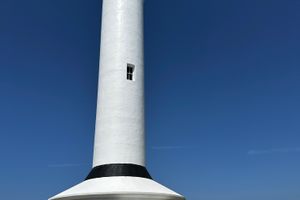A nominal $5 entry fee gets you into this beautiful coastal must-see. Keep an eye out for Arena Mina, the local lighthouse cat, guest relations manager, and rodent control specialist.
In addition to the beautiful and well maintained grounds, Point Arena offers modern accommodations in the former light house keeper’s buildings. The gift shop and museum offer visitors a chance to view the massive Fresnel lens up close.
Despite the removal of its large crystalline lens, the lighthouse is still in operation, using a powerful external LED array to blast a unique light pattern to passing ships. An additional $5 allows visitors entry to the tower, joining tour groups that climb to the top every 20 minutes or so.
Before committing to the climb, know that there is no elevator and the staircase spirals around the internal walls of the 115-foot tall lighthouse, the tallest on the West Coast. (The lighthouse at Pigeon Point in Pescadero, California, is the same height.)
Views from the top of the lighthouse are well worth it, offering a stunning 360-degree panorama of the coastal surroundings: everything from Devil’s Punchbowl (a sinkhole which could eventually swallow the lighthouse in the distant future) to Arena Rock, a massive natural stone platform the size of a football field, lurking ominously just 10 to 15 feet below the coastal waters. Ocean breakers can be easily seen crashing over the shallow platform, which devoid of other markers of scale are often mistaken by visitors for a cresting whale off the coast, although it is much much larger than that.
The ivory tower also sits only 4 miles from the San Andreas fault, which is why this current lighthouse is not the original structure. The original tower was irreparably damaged during the 1906 earthquake. The original brick tower was demolished and replaced with a more earthquake-resistant design. The company that built the current tower built factory smokestacks. Hence this design featured steel reinforcement rods encased in concrete. This made it the first lighthouse in the U. S. to use this type of construction method.
Tour guides take shifts occupying the glass housing at the top. Freed of its massive lens, the glass housing is roomy and open with stunning views protected on all sides by floor to ceiling glass. Guides stationed at the top regale visitors with the history of the site and point out unique sights. Bring a couple dollars in cash for the tip jar.
While visiting the top, visitors are afforded the special opportunity to walk outside on the balcony, just below the glass casing. Those with vertigo or a fear of heights may want to skip this privilege, as the winds can be so strong you may feel you will blow right off the tower. Hold onto your hats and sunglasses as well.
The grounds are a beautiful place to walk and admire several artistic installations, as well as a gazebo that overlooks the coastline. Bring a sandwich and enjoy a coastal picnic at one of the tables overlooking the sea.
